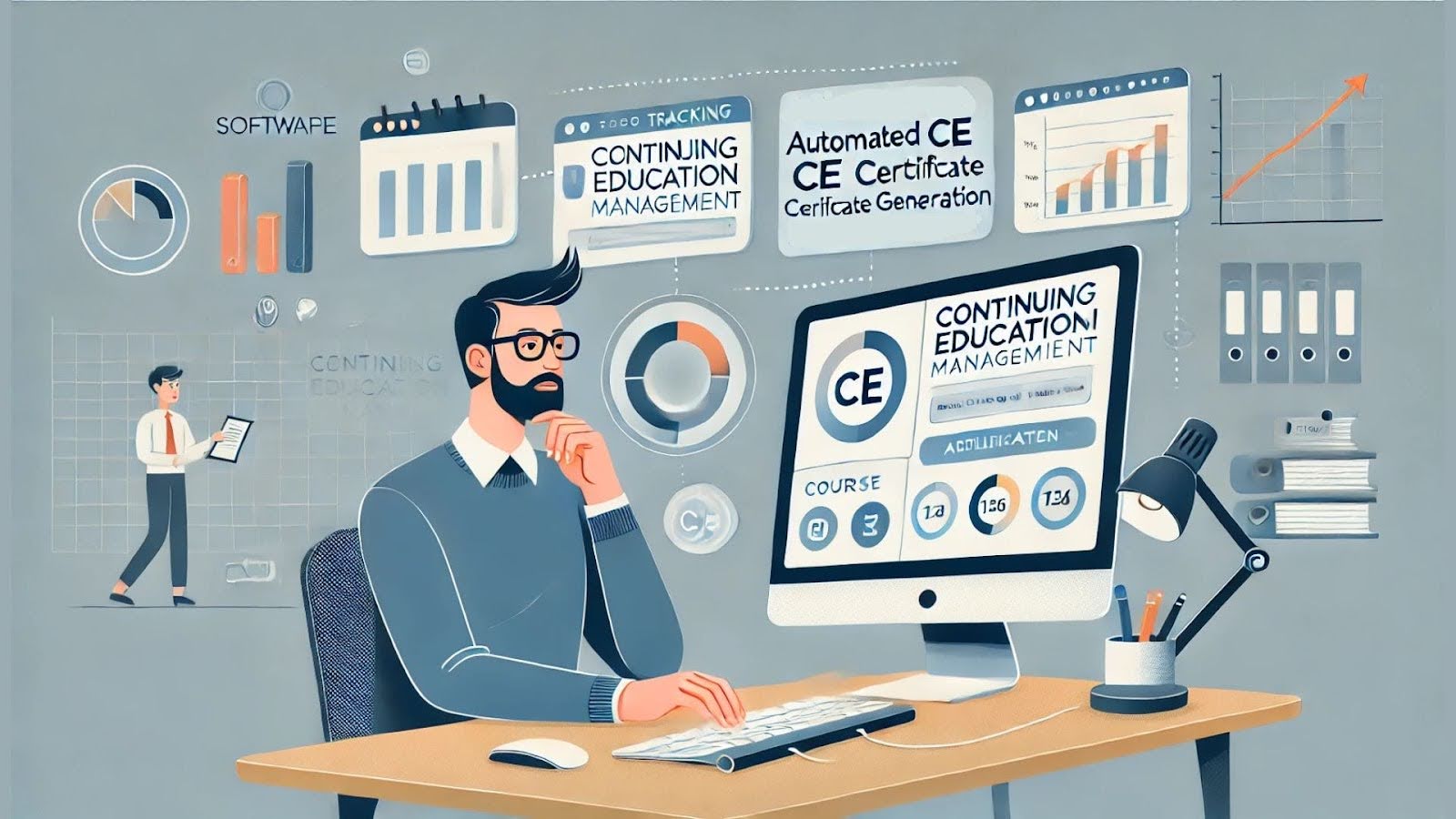Best Continuing Education Software for Effective Learning Management
The job market isn't predictable, so professionals need ongoing learning opportunities to stay competitive. Institutions must deliver flexible, accessible education that meets modern demands. Continuing education programs help learners gain new skills, advance their careers and meet industry requirements.
However, efficiently managing these programs can be a challenge for education providers. From course creation and enrollment to tracking learner progress and issuing CE certificates, institutions need a streamlined system that simplifies administration while enhancing the student experience.
The right continuing ed software allows administrators to manage course offerings, automate registration and provide a seamless learning journey for students. A user-friendly platform helps CE providers track completion rates, ensure compliance and scale programs effortlessly. With tools designed to engage learners and support both online and in-person education, institutions can focus on delivering high-quality instruction rather than juggling administrative tasks.
Investing in modern technology improves efficiency and elevates the overall experience for students and educators alike.
Key Features to Look for in Continuing Education Management Software
The best continuing education software makes it easy for institutions to manage courses, engage learners and streamline administrative tasks. From automated enrollment to advanced tracking capabilities, the right platform should support education providers in delivering high-quality learning experiences while reducing manual workload.

Intuitive Course Management for Seamless Learning
A well-designed system should simplify course creation, making it easy to organize course materials, update content and manage schedules. Administrators should have the flexibility to create and modify continuing education courses without needing technical expertise.
To maximize efficiency, look for a system that allows bulk uploading of course content, drag-and-drop scheduling and automated version control to ensure learners always have access to the most up-to-date information. Additionally, platforms that support multimedia integration—such as video lectures, interactive simulations and digital workbooks—enhance the student experience and cater to different learning styles.
Automated Enrollment and Registration
A smooth registration process keeps students engaged from the start. Look for a system that automates enrollment, manages payments and sends confirmations, reducing the need for manual oversight while ensuring a hassle-free experience for learners.
For instance, a professional association offering mandatory CE courses for accountants might experience a surge in registrations before annual compliance deadlines. An automated system with capacity controls and instant confirmations ensures that students secure their spots while preventing oversubscription issues.
Integrated Payment Processing for Hassle-Free Transactions
Education providers need a secure and efficient way to handle tuition payments, subscriptions and refunds. Built-in payment processing simplifies transactions, improves cash flow and ensures compliance with financial regulations.
Look for software that supports multiple payment methods, including credit/debit cards, ACH transfers and employer-sponsored billing. Platforms with automated invoicing, installment payment plans and tax compliance features make it easier for institutions to manage revenue without adding administrative complexity.
Analytics and Reporting to Track Learner Progress
Understanding learner engagement and completion rates is essential for improving programs. A strong platform should provide real-time analytics, allowing administrators to track student progress, identify trends and make data-driven decisions to enhance course offerings.
For example, if data shows that a large percentage of learners drop out before completing a specific module, administrators can investigate whether the content is too challenging, the format is disengaging or additional support is needed. With actionable insights, institutions can continuously optimize their programs to improve learner retention and success rates.
By choosing a continuing ed platform with these essential features, institutions can provide learners with a seamless, engaging experience that drives long-term success.
Top Continuing Education Software Solutions for Learning Management
Choosing the right software involves finding a platform that can scale with your needs, engage learners effectively and streamline the entire process for administrators. The best solutions support flexible learning formats, integrate with existing systems and provide robust data insights to drive program success.

Below are key factors to consider when evaluating platforms for continuing education programs.
Flexible Platforms for Diverse Learning Needs
Continuing education attracts a wide range of learners, from working professionals seeking career advancement to organizations providing workforce training. A platform that supports multiple learning formats—including live webinars, self-paced courses and hybrid models—ensures that programs remain accessible and engaging.
Advanced systems also allow for personalized learning paths, giving students control over how they progress through coursework. For example, a professional balancing full-time work and certification requirements may need the ability to pause and resume lessons without losing progress.
Cloud-Based Solutions for Anytime, Anywhere Access
Modern learners expect education to fit into their schedules, not the other way around. Cloud-based continuing education software removes barriers by allowing users to access courses from any device at any time. Flexibility is essential for professionals completing CE requirements or institutions managing large-scale programs.
With secure cloud storage, administrators can easily update course materials, ensure compliance and maintain a seamless experience for new users and returning learners alike.
Scalable Systems to Support Growing Programs
As demand for continuing education grows, institutions need a system that can expand without disruption. A scalable platform accommodates increasing enrollment numbers, new course offerings and additional faculty or instructors.
The best solutions also integrate with student information systems (SIS) and learning management tools to centralize data and simplify workflows. When evaluating software, look for features that support:
- Automated enrollment and billing to handle high volumes of students
- Adaptive learning paths to meet diverse learner needs
- Custom branding options to maintain institutional identity
- API integrations for seamless connections with existing systems
A scalable system ensures that as programs expand, administrators can manage growth without added complexity.
Advanced Engagement Tools to Improve Learning Outcomes
Keeping learners motivated affects how well programs succeed. Interactive features like discussion forums, gamification and progress tracking can enhance the student experience and improve completion rates.
Studies show that incorporating interactive features like gamification and real-time feedback can boost learner engagement by 25% and improve knowledge retention by 15%. This highlights the power of engagement-driven learning tools in continuing education programs.
A platform that offers built-in communication tools—such as automated email reminders, instructor messaging and real-time notifications—helps learners stay on track. Additionally, video-based learning, knowledge checks and competency-based assessments ensure that students retain information and apply it effectively in their professional fields.
How the Right Software Enhances Continuing Education Programs
Choosing the right continuing ed software leads to a seamless, engaging experience for learners and simplified operations for administrators. Universities and colleges achieve higher completion rates with a well-designed platform through enhanced accessibility, boosted engagement and streamlined program management.

Improving Accessibility for Lifelong Learners
Continuing education attracts a diverse audience, from working parents to career changers and retirees looking to build new skills. A flexible learning management system ensures that students can access course materials anytime, anywhere, whether they’re completing lessons between meetings or studying late at night.
Mobile compatibility, self-paced options and intuitive navigation allow learners to progress at their own speed without feeling restricted by rigid schedules. Institutions that prioritize accessibility improve student satisfaction while expanding their reach to a broader audience.
Enhancing Engagement Through Interactive Learning
Keeping students engaged is one of the biggest challenges in online education. The right software incorporates interactive elements such as live discussions, video-based lessons and gamified assessments to make learning more dynamic.
For example, a healthcare professional completing a certification course may benefit from simulation-based training that mimics real-world scenarios, reinforcing key concepts in a meaningful way.
Streamlining Administration for Maximum Efficiency
Managing continuing education programs involves juggling multiple tasks—enrollment, compliance tracking, CE certificate issuance and reporting. A robust platform automates these processes, reducing manual work and minimizing errors.
Features like real-time progress tracking and automated reminders keep learners on schedule, while built-in compliance management ensures that institutions effortlessly meet industry standards. By simplifying administrative workflows, organizations can focus more on course development and student engagement rather than paperwork and logistics.
The right continuing education software acts as a bridge between student success and institutional efficiency. By improving accessibility, enhancing engagement and streamlining administration, CE providers can deliver high-quality learning experiences that drive long-term success.
Choosing the Best Software for Your Institution
With so many continuing education platforms available, finding the right one can feel overwhelming. The best software creates a seamless experience for learners, simplifies administration and scales with your institution’s needs.
Whether you’re running professional certification programs, workforce development initiatives or university-led continuing education courses, choosing a platform that aligns with your goals is essential.
Key Considerations for Higher Education Institutions
For universities and colleges, continuing education programs are a growing priority, serving non-traditional students, professionals and alumni seeking career advancement.
The ideal platform should integrate with existing SIS, allowing for seamless enrollment and data tracking. Additionally, strong reporting tools help administrators measure program success, track learner progress and ensure compliance with accreditation bodies.
A system that supports flexible course delivery—whether online, hybrid or in-person—ensures that institutions can meet the needs of diverse learners while maintaining a high-quality student experience.
Factors to Evaluate for Workforce Development Programs
Workforce development programs need a platform that supports fast enrollment, real-time tracking and employer partnerships. Organizations offering skills-based training or corporate learning should look for software with built-in compliance tracking, customizable certification pathways and reporting tools that demonstrate ROI to employers and industry partners.
A scalable solution with self-paced learning options, mobile accessibility and interactive engagement tools ensures that busy professionals can complete training on their terms without sacrificing quality.
Institutions that invest in the right platform can improve learner engagement, streamline administrative processes and position themselves as leaders in continuing education.
Elevate Your Continuing Education Courses with the Right Technology
The success of a continuing education program depends on great course content, but it also requires the right technology to support learners, streamline administration and drive engagement. Institutions that invest in modern, flexible learning management systems can enhance the student experience, improve completion rates and ensure their programs remain competitive. Prioritizing accessibility, automation and interactive learning, allows for education providers to create a seamless journey for students while reducing administrative burdens.
Modern Campus offers a purpose-built solution designed specifically for higher education institutions looking to scale their continuing education programs. With robust tools for course creation, automated enrollment, learner progress tracking and CE certificate management, we empower institutions to deliver engaging, high-quality education. Our intuitive, mobile-friendly platform ensures that learners can access content anytime, anywhere, while administrators benefit from powerful integrations, real-time analytics and compliance management. Request a demo today to see how Modern Campus can help streamline your programs and drive student success.
Last updated: May 23, 2025

